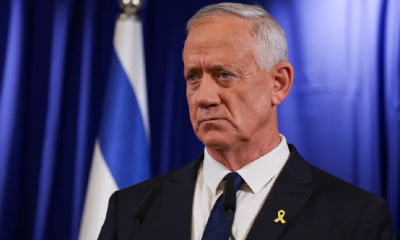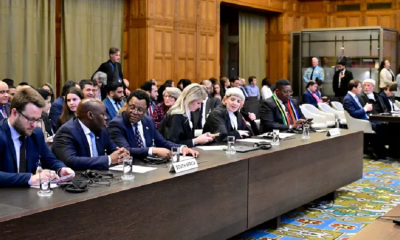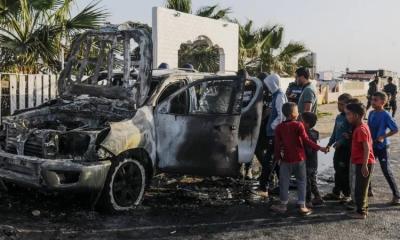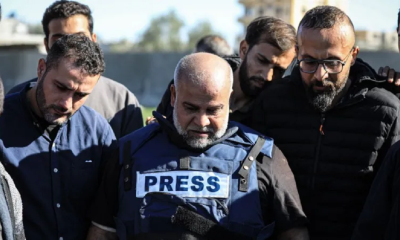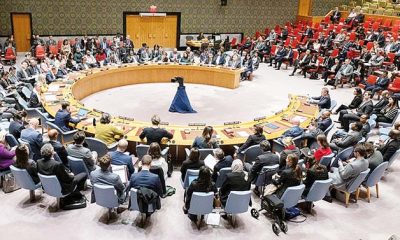Opinion
The mathematics of Israel
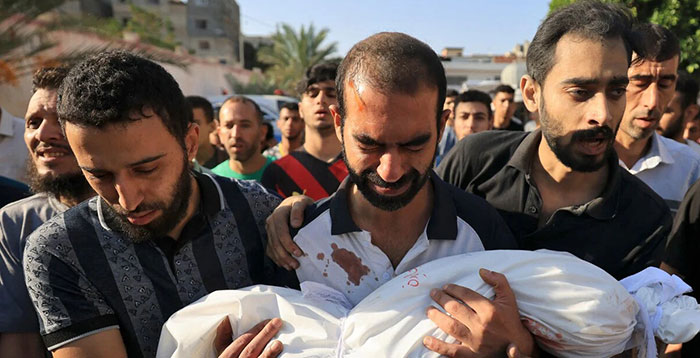
Zionism plus impunity:
By Bishop Duleep de Chickera
When the Secretary General of the UN, condemned the Hamas attack of 7/10 and cautioned the world to see it in context, he came under harsh criticism from Israel. But he was right. It is misleading to enter a conflict in the middle of the story.
The story of the Israeli-Palestinian conflict begins around the close of the 19th C-CE when organized groups of diaspora Jews descended on Palestine. They claimed the land was promised to them by God.
At that time Palestine was populated mostly by Arab Palestinians, (Muslims and Christians), and smaller communities of Jewish, Druze and Samaritan Palestinians, to whom the Jewish claim was audacious. Palestine was their land.
Today’s massacre of Palestinians updates the story. It tells of how a tenacious toe hold of a century ago has subjugated their land. Those who lived on it have lost their land, freedom, and more. Trapped and targeted, they face annihilation.
A mix of Zionism and impunity explain this travesty of justice.
Zionism
This ideology was provoked by the incessant anti-Semitic pogroms in Christian Europe, which persecuted Jews as “Christ Killers”. Under the direction of Theodore Herzl, the father of Zionism, Jewish suffering was shaped into a clamour for a homeland in Palestine.
Zionism is not Judaism. It has become an ethno-nationalist agenda, bent on occupying all of Palestine and ridding it of Palestinians.
Conversely, Judaism is the authentic religion of the Jews. Because it equates belief in God with loving care over ones’ neighbor, it has potential to co-exist with others. This difference explains todays’ opposition of numerous Jewish Israelis to the Zionist Israeli agenda.
The convergence of two factors has helped the Zionist agenda. The Balfour declaration that devised a homeland for Jews in Palestine, reflected European guilt. European Jews had to be compensated for European atrocities, but far away from Europe. Provision in the declaration for the protection of the rights and privileges of the then inhabitants of the land, has been proved to be a lie.
The other factor was the prevailing climate of western colonialism. The Zionist invasion of Palestine occurred when the plunder of other lands by some greedy nations, was the norm.
Impunity
Zionism alone could not have turned Israel into the bully it has become. The manipulation of western guilt, to equate any criticism of Zionism with anti-Semitism, earned Israel limitless impunity. Recent hearings by Congress into alleged Anti-Semitic protests in some Universities in the US, illustrates how this manipulation works.
Zionist impunity first manifest under the British mandate (1920-1948). Palestinians who fought Jewish invasion were branded as insurgents. Their leaders were exiled in the Seychelles and in a practice emulated by Zionist Israel, their dwellings, demolished. When the Palestinians revolted against Jewish land acquisition, Britain declared Martial law and trained Jewish Night Squads to hit back. These squads later evolved into the Israeli Defense Force (IDF).
When the conflict got out of hand, British attempts to partition the land and regulate Jewish immigration and land acquisition, came too late. Zionist Israel had smelt the power of impunity.
War and strategies
World War 11 and the horrendous holocaust, brought a flood of Jewish refugees into Palestine and further bolstered the Zionist agenda. With the declaration of the state of Israel in 1948 after the British mandate, war broke out between Israel and the surrounding Arab states, in support of the Palestinians. Israel-Egyptian tensions in 1967, led to a second devastating war.
Both wars stirred the trauma of the holocaust and doubled Zionist Israel’s resolve for a land of its own. Consequently, a more fervent fighting force, twice crushed Israel’s adversaries. A calculated cycle of forcible occupation followed; it expanded Israel’s boundaries to close in on its Zionist agenda.
As hundreds of Palestinian villages, mosques and churches were destroyed, millions of Palestinians displaced, exiled or detained and millions of acres of Palestinian land acquired; armed Israeli settler colonies were built where Palestinians lived and farmed, before.
Soon, ‘settler only’ roads and security walls bifurcated Palestinian villages and undermined Palestinian unity. Whenever friction developed between armed settlers and desperate stone throwing Palestinians, the IDF moved in to complete the next cycle of detention, displacement, more settler colonies and so on.
By the end of the 1948 war, Israel had occupied 77 % of Palestinian land including most of Jerusalem and the remaining 22% was annexed during the 1967 six-day war. At the beginning of 2023 the Israeli war machine had illegally established more than 150 settler colonies on Palestinian land. With all of Palestine under Israel, the subjugation of a people on their own soil was almost complete.
Two Israeli laws reinforced the Zionist agenda of total occupation. The Right to Return Law, welcomed Jews from anywhere in the world, and the draconian Absentee law, annulled Palestinian ownership after they were forced off their land.
With the inflow of large numbers of Jewish refugees and immigrants and the prevention of over two million Palestinian refugees from returning, the demography of Palestine changed drastically.
Israeli impunity, ensured by the US and its western allies had made these glaring violations of international humanitarian law and human rights, appear normal. As a victim of despicable crimes became a ruthless oppressor; its allies stood on the wrong side of history.
In the meantime, global endorsement for Palestinian self- determination, UN recognition of a Palestinian authority, UN observer status and the declaration of a Palestinian state in 1988, did little to change Israel’s attitude.
This rigidity provoked the rise of groups like the PLO, determined to liberate Palestine and its people from the yoke of Zionist occupation. This was typical of all peoples under wanton western colonialism. Had these Palestinians resisted German invasion during WW 11, they would have been honored as ‘The Resistance.’
With time, the secular PLO under Yasser Arafat, changed its stance to talk peace with the leftist Israeli PM, Rabin. Rabin’s daring to shift from violence to negotiations, cost him his life. Later on the emergence of Hamas, an armed Islamic group, intensified the conflict, as killings increased on both sides. Strained relations between the PLO and Hamas finally led to their separate but limited control over the West Bank and Gaza respectively.
Gaza
In 2005, the densely populated Gaza strip was disengaged as a non-profitable, volatile zone by Israel. After Israeli settlers in Gaza were compensated and resettled in the Palestinian West Bank, the Israeli withdrawal turned into a siege. The borders of the strip came under IDF control, and all movement in and out, including the supply of food, medicine and fuel by the UN Relief Work Agency, was brought under its scrutiny. Israel, a law to itself, had Gaza at its mercy.
Then came the incidents of 7/10.
Today the relentless bombardment of Gaza, the massacre of innocents, the targeting of hospitals, UN workers and Media personnel, as well as embargos on food, medicine and fuel, demonstrates the enormous power of unchecked impunity. In the name of ‘self-defense’ arbitrarily conferred by the US and some western allies, Israeli bombardment threatens to go on till Hamas is liquidated. The soaring numbers of civilian deaths and the recent white flag incident, in which Israeli hostages were killed on sight by the IDF, suggest that civilians will have to die for Hamas to be liquidated. After Gaza, it will be the West Bank, if not immediately, eventually.
A shared land
An ideal solution to this conflict, in an ideal world, is a shared land. If this is ever possible, the Palestinians will be free on their land and Israel free to live- ’in’-a land they believe to be a promise.
But there are two daunting prerequisites to a shared land.
1. It will not happen until the US protection of Israel stops, the discriminatory right of veto on the UN Security Council is repealed and the UN is empowered to do its work independently.
2. It cannot happen until investigations into war crimes by Israel and Hamas; and crimes against humanity and ethnic cleansing by Israel; are in place. Urgent negotiations cannot postpone investigations. Justice delayed in the name of peace, absolves the guilty.
If these requirements are bypassed, our world is likely to witness another genocide under our watch.
With peace and blessings to all!
Opinion
Praise to ex-President Ranil Wickremesinghe!
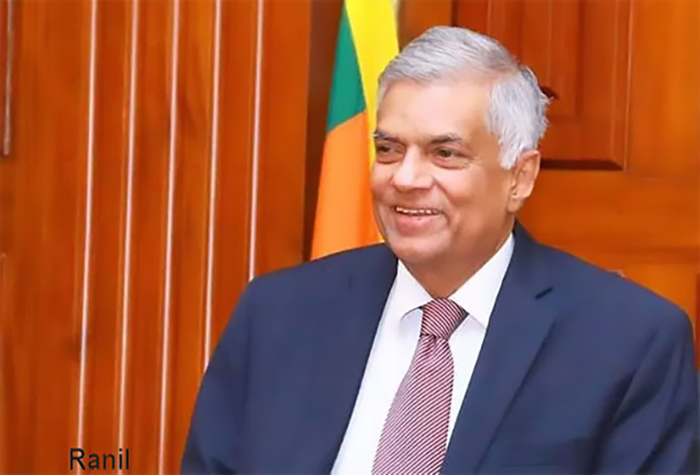
In the despicable absence of an urgent practical response on the part of the JVP-Anura Kumara Dissanayake-led NPP government to the devastating 28th March earthquake in Myanmar, ex-president Ranil Wickremesinghe has made a very timely and sensible proposal regarding how to assist our disaster stricken fellow humans in that country. ex-president Wickremesinghe! Thank you very much for saving, at least to some extent, Sri Lanka’s still unsullied reputation as a sovereign state populated by a most humane and hospitable people. You have again demonstrated your remarkable ability to emerge as an able state level troubleshooter at critical moments, this time though, just by being a mentor. It is a pity that you don’t think of adopting a more universally acceptable, less anglophile version of principled politics that will endear you to the general electorate and induce the true patriots of the country to elect you to the hot seat, where you will have the chance to show your true colours!
The ordinary people of Myanmar (formerly called Burma) are remarkably humble, polite and kind-hearted just like our fellow ordinary Sri Lankans. There’s a natural cultural affinity between us two peoples because we have been sharing the same Theravada Buddhist religious culture for many centuries, especially from the 4th century CE, when Buddhism started making gradual inroads into the Irrawaddy Valley through trade with India. Whereas Buddhism almost completely disappeared from India, it flourished in Sri Lanka and Burma. Nearly 88% of the 55 million present Myanmar population profess Buddhism, which compares to 72% of the 22 million population in Sri Lanka. Wickremesinghe has been mindful enough to take a glance at the historicity of close Myanmar-Sri Lanka relations. And he didn’t mince his words while giving some details.
At the beginning of his statement in this connection (which I listened to in a video today, April 1, 2025), Ranil Wickremesinghe said that our government has expressed its sorrow (but little else, as could be understood in the context). Countries near and far from Myanmar including even partly affected Thailand, and India, China, and distant Australia have already provided emergency assistance. Referring to the special connection we have with Myanmar as a fellow Theravada Buddhist country, he said that both the Amarapura and Ramanna nikayas brought the vital higher ordination ritual from there. We must help Myanmar especially because of this historic relationship.
When an earthquake struck Nepal, the birthplace of the Buddha, in 2015, we sent an army team to assist. On that occasion, Sri Lanka was the second country to provide relief, India being the first, with China becoming the third country to come to Nepal’s help. Today, India, Thailand, Malaysia, China and Australia have dispatched aid by now. Last year Sri Lanka gave 1 million US Dollars for Gazan refugees. We need to take a (meaningful) step now.
Wickremesinghe proposed that the army medical corps be sent to Myanmar immediately to set up a temporary hospital there. The necessary drugs and other materials may be collected from Buddhist and non-Buddhist donors in Colombo and other areas.
Emphasising the ancient friendly relationship between Sri Lanka and Myanmar, Wickremesinghe mentioned that King Alaung Sithu I (of the Pagan Dynasty, 1090-1167 CE) sent help to (Prince Keerthi who later became) King Vijayabahu the Great (1055-1110 CE) to defeat and drive away from the island the occupying Cholas after a 17 year long military campaign. The grateful Lankan monarch Vijayabahu, during his reign, offered the Thihoshin Pagoda (name meaning ‘Lord of Lanka’ pagoda, according to Wikipedia) and a golden Buddha image to the Myanmar king. (This pagoda is situated in Pakokku in the Magway region, which is one of the six regions affected by the recent earthquake. I am unable to say whether it remains undamaged. Though the monument was initiated during Vijayabahu’s lifetime, the construction was completed during the reign of King Alaung Sithu I {Wikipedia}).
Wickremesinghe, in his statement, added that it was after this that a strong connection between Sri Lanka and Myanmar started. In some Buddhist temples in Myanmar there are paintings by ancient Lankan painters, illustrating Jataka stories (Stories relating to different births of Buddha). Among these, Wickremesinghe mentioned, there is a painting depicting the duel between (the occupying Chola king of Anuradhapura) Elara and (his young native challenger from Ruhuna prince) Dutugemunu. (Although Wickremesinghe did not talk about it, a fact well known is that there is a copy of our Mahavamsa in Myanmar. In reporting the ex-president’s speech, I have added my own information and information from other sources. I have put this within parentheses)
Let’s hope President Anura Kumara Dissanayake is wise enough to derive some benefit from his predecessor’s mentoring in the name of our beloved Motherland.
Rohana R. Wasala
Opinion
Assisting solar power debate in Cabinet

Authors: Directors of Solar Village SDG CIC
www.solarvilllagesdg.org
I.M. Dharmadasa (Emeritus Professor), Nilmini Roelens (Solicitor) and Saroj Pathirana (Journalist)
The purpose of this article is to inform the Cabinet discussion on Solar Power proposed by the Ceylon Electricity Board (CEB)
Net metering and the Prosumer
The CEB has put forward a motion to the Sri Lankan Cabinet which proposes to reduce the unit price payable under the various net metering schemes to the “prosumer” (the owner of a solar panel system).
A prosumer is a blend of producer and consumer, referring to individuals who both create and consume. This is based on the notion that most producers of electricity through self-owned solar panels generate more than double their own needs as consumers. It thus enables the prosumer to connect to the national grid and receive money on a pay back scheme from the CEB for the excess electricity they produce.
What is this debate about?
Currently there are four schemes.
The Public Utilities Commission of Sri Lanka explains the various schemes involving roof -top solar solutions thus under a heading published in October 2023 – Rooftop Solar PV Connection Schemes. The two most noteworthy schemes are the Net plus and the Net plus plus schemes.
https://www.pucsl.gov.lk/rooftop-solar-pv-connection-schemes/
Through the NET Plus Plus Scheme CEB regards the prosumer as a mini power plant holder which maximises roof top generation well beyond the prosumer’s own needs making maximum use of extra roof space. This would work well for schools and companies with large buildings. CEB used to pay Rs. 37 per unit to the prosumer for up to 500kW. This unit price was available between 26 October 2022 to 1 July 2024. However, as of 1 July 2024 the unit price was reduced to Rs. 27.
We understand the new CEB proposal to the cabinet is to scrap this scheme altogether.
In relation to the Net Plus scheme which is the more accessible and popular scheme for ordinary householders the current CEB proposal is to reduce the unit price even further to Rs. 19 for solar power systems generating less than 20 kW, whilst for those generating between 20 – 100 kW the unit pay back will be Rs.17 and those generating between 100 – 500 kW will receive Rs.15 per unit.
The installation costs of a 5-kW solar panel is now around Rs 1.0 million. The cost of solar panels has in fact come down over the years and the units are recyclable. The lifespan of a solar unit is expected to be in the region of 22 to 25 years. There are now over 300 active solar companies in Sri Lanka. This is a rapidly growing sector with the prospect of generating employment for tens of thousands of young Sri Lankans for many years to come as technicians, administrators and entrepreneurs. The potential advantages for the economy are extensive Sri Lanka’s growth of the renewable energy sector using freely available sunshine available virtually all year-round given the geographical proximity to the equator
It is not just about reducing the electricity bills of the prosumer. This green energy solution would also mean we avoid the heavy annual cost of the import of fossil fuels into Sri Lanka which very seriously affects its balance of payments each year. The unwarranted need for environmentally damaging energy sources like coal, diesel and nuclear (with its inherent dangers and enormous costs), etc., will lead to a meaningless downward spiral of more debt, enhanced climate risk and pollution.
The intermittency argument
The argument of intermittency of renewables is a misguided premise. Some may argue that seasonal variations of renewables such as solar or hydro power may make them unreliable. This can very easily be remedied by investment in a smart grid. This can be done by upgrading the existing transformers and grid lines. A policy decision would be required at cabinet level to advise the CEB to reinvest any profits for this purpose.
Green Hydrogen is the future
Solar generated power can be harnessed to invest in Green Hydrogen solutions which could mean that rather being an importer of fossil fuels, that the rest of the world is turning away from, Sri Lanka becomes an exporter of green hydrogen to countries in the northern hemisphere where sunshine is scarcer.
Picture what it could do to the Sri Lankan economy if, rather than being dependent on imports of polluting and expensive fuel which can exacerbate the climate crisis, we transform our island into an eco-tourist paradise and become an exporter of clean green hydrogen.
Green hydrogen is created by splitting water molecules into its components of Hydrogen and Oxygen. The hydrogen gas can be compressed and stored for export. The minimum voltage required for splitting the water molecule is about 1.50 Volts DC and scaling up and commercialisation is happening throughout the world currently.
Rebranding Sri Lanka as a renewable energy island
To limit imports of fossil fuels for automobiles, a policy decision at governmental level could provide concessions for electric cars for solar roof owners and encourage the use of solar powered charging stations. The annual cost of imports of petrol and diesel would reduce overtime as Sri Lanka encourages clean and green electric cars.
Whilst the rest of the world is turning to renewable energy with alacrity, Sri Lanka ought not turn to fossil fuel imports in breach of its commitments to the international community.
In 2015 Sri Lanka signed up to the United Nations 2030 Agenda. Ahead of the Paris Summit Sri Lanka set out its climate action plan which the UN Framework Convention on Climate Change (UNFCCC) stated “Countries have agreed that there will be no back-tracking in these national climate plans, meaning that the level of ambition to reduce emissions will increase over time.”
(https://unfccc.int/news/sri-lanka-submits-its-climate-action-plan-ahead-of-2015-paris-agreement)
Sri Lanka has a real opportunity to rebrand itself as a renewable energy island. This means moving towards the commitments made at UNFCC – COP25, Sri Lanka Country Statement in Madrid in December 2019:
“Sri Lanka recognises the importance of the role of COP and highlights the need to take effective and definitive steps for finalising the follow up actions of the Paris Agreement.
The rise of the global mean temperature and the resulting changes have created adverse impacts on key sectors of Sri Lanka, such as agriculture, forestry, biodiversity, marine and fisheries, tourism and energy (hydro power) sectors, leading to disastrous effects on its people, ecosystems and economy. According to official statistics from 2008 to 2018, droughts, floods and landslides have affected over 15 million people, and losses and damages resulting from these calamities have been borne by Sri Lanka’s national budget… Sri Lanka is committed to inclusive and participatory climate actions to ensure that affirmative actions are taken to address the vulnerabilities of climate change.“https://unfccc.int/sites/default/files/resource/SRILANKA_cop25cmp15cma2_HLS_EN.pdf
Why is reduction of the unit price a very regressive, harmful measure?
The reduction will discourage the use of clean renewable energy in favour of higher imports and a move towards dangerous and expensive sources of energy.
The consequences of a reduction of unit price will thus be far reaching beyond the loss to the prosumer.
Lithium battery storage options mean that even when the sun stops shining at night or in the wet season the solar panel produced energy can continue to be used. It is very likely that current solar companies will need to diversify to survive and move towards lithium battery storage solutions and inverters so that year long, 24-hour access to energy is available without recourse to the national grid for their customers. As individuals and institutions go off grid CEB’s income will dwindle in the long run as the private sector takes over.
Recommendations to the cabinet
We make the following recommendations to the Government of Sri Lanka:
(i) At present we have a fragile grid, and the CEB should strenuously endeavour to minimise energy leakages and improve the grid by replacing weak transformers and grid lines. Such continuous improvements will enable us to move towards a “Smart Grid” enabling absorption of large amounts of intermittent renewable energies like wind and solar.
(ii) At present we have ~1500 MW of renewables installed, comparable to hydroelectricity. When solar power is plentiful during the daytime, hydro power can be reduced simply by controlling the water flow without any technical difficulties. This is one way of assuring energy storage while balancing the grid energy.
(iii) Another solution for this is pumped-water storage plants. It is important to follow through with such measures which have now been under discussion for some time.
(iv) The future energy carrier is green hydrogen (GH) produced by electrolysing water using both wind and solar. A global Green Hydrogen revolution is taking place, and GH can be used to run vehicles using fuel cell technology. Trains and buses are being run with GH technology in Europe. GH can also be converted into ammonia and methanol to produce fertilizer and be applied for other industrial uses. Sri Lanka must not be left behind.
(v) GH can be stored and burned whenever energy is needed, especially during nighttime. Only water vapour is produced during the burning of hydrogen without any air pollution. Sri Lanka already has the Sobhadanavi LNG plant which is almost ready to use. Since we must import LNG to run this power plant, we should be able to reduce the LNG import bill by half by mixing the natural gas (methane) with the locally produced GH. See here:
(vi) Local solar energy companies should install high quality solar energy systems and provide “after sale services” in accordance with their guarantees.
(vii) PV companies should also be encouraged to collaborate with local electronics departments to manufacture accessories like inverters and other components needed for these systems, creating new jobs, and reducing the total cost of the systems.
(viii) In addition to grid tied solar roofs, the PV companies should also market hot water systems and water pumping systems. As a country reliant mainly on agriculture, solar water pumping and drip irrigation systems, especially in the dry zone, provide a huge potential for increasing food production.
(ix) Battery capacities are improving, and costs are coming down. This can be encouraged pending replacing grid infrastructure.
(x) It is important to increase public awareness through government funded campaigns. The public should recognise the dangers of using imported and expensive fossil fuel and the importance of using renewables.
(xi) The public should also recognise the advantages of having a clean environment, health benefits and enhanced living conditions.
(xii) A community development project called “Solar Village” to empower needy communities, accelerate their sustainable development, reduce poverty and take climate action has been developed over the past two decades. Seven solar villages have been established and funding for three more solar villages have been obtained.
Solar Village SDG, a UK based community interest company has been established to encourage the use of renewables and to pilot programmes which will support sustainable development goals. This includes providing access to a quality education for all via smart rooms which will be set up alongside solar villages in rural schools. Such initiatives could be encouraged and supported.
Opinion
How monks practice Buddhism in Sri Lanka
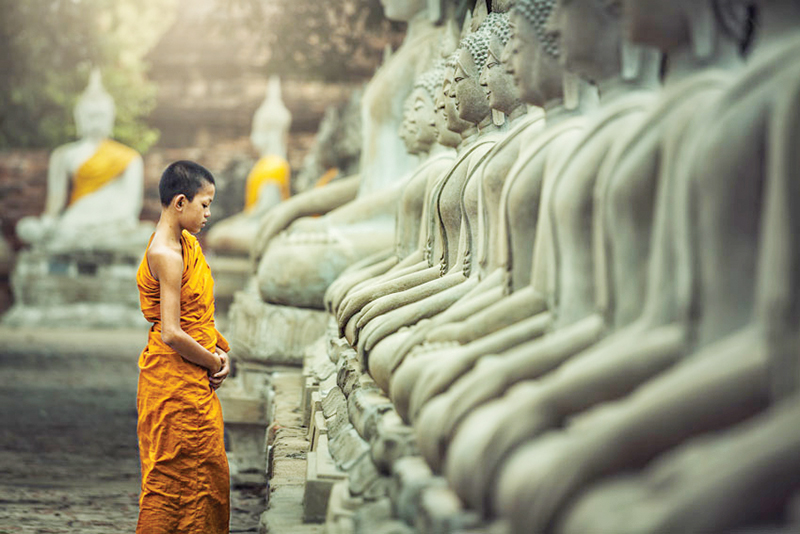
Time was when we had to observe the five precepts chanting in front of the omnipresent Buddha statue in every Buddhist household, and pay homage to parents straight afterwards. Attend mandatory Sunday schools, trek about 6 miles (return) to Moratu Vidyalaya’s main hall together as a family on Fridays to listen to a sermon by erudite visiting monks from the Vajiraramaya and elsewhere.
Having been settled in the UK for half a century, I can only go by what I read and hear from Sri Lankan friends and families. All those practices seem to have changed for the worse, sadly! Living in luxury, temples are run on business models nowadays! Monks ask what they wish to eat at alms-givings, including pork, etc., tell how much it costs the laypeople to invite them, etc! Unbelievable to say the least! I dare say it seems to start from the top of the hierarchy – the Kandy Temples, where the prelates live and are patronised by all politicians from Presidents, Prime Ministers and others! Some monks engaging in politics is not uncommon! For example, a recent statement made by Ven. Dodampahala Rahula Thera during a religious ceremony held to bless former President Ranil Wickremesinghe on his birthday has sparked widespread discussion on social media.
Speaking at the event, Ven. Rahula Thera had claimed that he had advised then-President Wickremesinghe not to import fuel ahead of the 2024 Presidential Election. However, the Thera has since clarified that the remark was made in error due to the pressure of the moment. Pertinent question is why did he choose such intervention?
All these are in such sharp contrast to Buddhist monks in the Western world and South East Asia where they shun luxury to lead a truly monastic lifestyle in order to practise what they preach.
Respected and loved in his own country as a man of great wisdom, Ajahn Cha was also instrumental in establishing Theravada Buddhism in the West. Beginning in 1979 with the founding of Cittaviveka commonly known as Chithurst Buddhist Monastery) in the United Kingdom, the Forest Tradition of Ajahn Chah has spread throughout Europe, the United States and the British Commonwealth. The dhamma talks of Ajahn Chah have been recorded, transcribed and translated into several languages.
More than one million people, including the Thai Royal Family attended Ajahn Chah’s funeral in January 1993 held a year after his death due to the “hundreds of thousands of people expected to attend”. He left behind a legacy of dhamma talks, students, and monasteries. The little I know of Buddhism teaches me to practice His Noble Teachings. It follows therefore the importance of listening to practising Buddhist monks who actually command respect, not by their titles! They don’t mean anything to me. Not familiar with various Nikayas, I think Buddhist monks should have both their shoulders properly covered in the interests of propriety! Though not a vegetarian, I believe in Ahimsa as even little spiders feel pain. Though my wife is scared of them, I tell her they are scared of her, more to the point! So, I catch the innocent crawly creatures by hand to throw them out of harm’s way! We have stopped the practice of throwing inevitable food waste into Council provided bins, instead collect them on a regular basis to feed wildlife we have in abundance around rural Wales we live in. They are all gone the following day including old marrow bones after our two little dogs finish with them! It gives us great pleasure! In the end, it all boils down to respecting Mother Nature! It’s Mother’s Day today to remember Mother Nature and how proud I am of my surname!
Sunil Dharmabandhu
Wales, UK
-

 News5 days ago
News5 days agoBid to include genocide allegation against Sri Lanka in Canada’s school curriculum thwarted
-

 Sports6 days ago
Sports6 days agoSri Lanka’s eternal search for the elusive all-rounder
-

 Sports2 days ago
Sports2 days agoTo play or not to play is Richmond’s decision
-

 News6 days ago
News6 days agoComBank crowned Global Finance Best SME Bank in Sri Lanka for 3rd successive year
-

 Features6 days ago
Features6 days agoSanctions by The Unpunished
-

 Features6 days ago
Features6 days agoMore parliamentary giants I was privileged to know
-

 Latest News4 days ago
Latest News4 days agoIPL 2025: Rookies Ashwani and Rickelton lead Mumbai Indians to first win
-

 Business1 day ago
Business1 day agoStrengthening SDG integration into provincial planning and development process


